Over 90% of Americans will experience back pain at some point in life, and it is the second most common reason people visit a doctor. Thankfully, most back pain resolves within 6 to  12 weeks, no matter what treatment is obtained.
12 weeks, no matter what treatment is obtained.
A small percentage of individuals, approximately 5 to 10%, will not have their pain resolved and it will become chronic. The definition of acute back pain is pain that lasts for three months or less. If pain persists longer than this time frame, it is called chronic and It may take more aggressive pain management to reduce the discomfort.
According the Institute of Medicine report in 2011, over 115 million Americans suffer from chronic pain, which is approximately one third of the whole country!
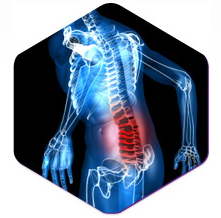
There are many reasons an individual develops acute back pain. One of the most common Is a back sprain or strain. This is a result of an injury during either lifting or sporting activities or potentially from an auto accident. The layman’s term is that a persons back “goes out”, and refers to any number of conditions that end up with the individual in excruciating pain.
It may be that the pain started upon waking up in the morning, after a sneeze, potentially after lifting up something very light, or any number of activities that you would not expect to lead to significant back pain. Or it could be from lifting something very heavy or a traumatic incident.
When back pain occurs out of the blue, it may be that the person has a degenerative disc that has sustained a tear and significant pain associated with it. This does not need to be from a high energy activity, it could be something seemingly minor.
Spinal Infection – in the Disc or Vertebrae
Less common reasons for acute back pain include infection, tumor or a fracture. Infection most commonly occurs in individuals who are immunosuppressed such as an uncontrolled
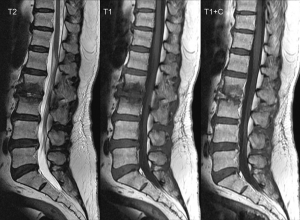
This is what discitis looks like on an MRI
diabetic, someone with a transplant on immunosuppressive medications, or potentially an individual who is abusing IV drugs.
During the adolescent years, an infection may occur inside the disc space which is called discitis. The person may have no immunosuppression or history of drug use at all. It is unclear most of the time why discitis occurs spontaneously. infection in adults usually occurs inside one of the spinal vertebrae rather than the disc initially and is termed osteomyelitis. This is what discitis looks like on an MRI.
Call (602) 507 – 6550 to schedule your Appointment TODAY!

Spinal Fractures
When a spinal fracture occurs in a younger individual, it is usually due to a trauma such as a skiing injury, auto accident, or a fall from a significant height. If a fracture occurs in a younger person and no trauma was involved, suspicion should be high for a tumor and the
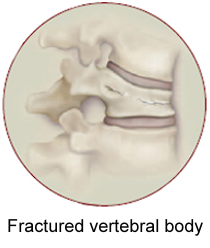
Vertebral compression fractures respond well to bracing or a vertebroplasty procedure.
work up appropriate.
Fractures that occur in older individuals are often from osteoporosis. Usually these are seen on x-rays along with an MRI. Less commonly, a fracture in an older individual may occur from either a primary tumor or from a metastatic cancer.
Herniated Disc
Another reason a person may have acute low back pain is due to a herniated disc that is pushing on a nerve root. At times, a disc herniation may cause no pain whatsoever in the back or the leg.
Or it may cause leg pain due to the pinched nerve roots, but no back pain whatsoever. Or an individual may experience both low back pain and significant leg pain at the same time (the worst possible scenario).
Spinal Arthritis and Degenerative Disc Disease
The most common reason that older adults experience acute low back pain is from a flareup of arthritis. This is no different then if a person has hip or knee arthritis, how it can 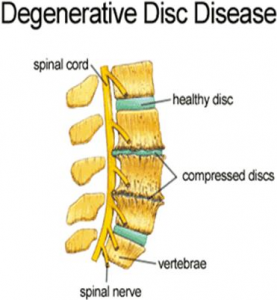 flare up with painful exacerbations from time to time.
flare up with painful exacerbations from time to time.
Younger individuals can also have pain due to arthritis. This may be due to post traumatic arthritis where cartilage was damaged secondary to a car accident. Or it may be due to degenerative disc disease that is causing pain that just will not subside.
In younger individuals, between 20 to 50, low back pain may be due to a flareup of one’s degenerative disc disease. With a degenerative disc, the person may have a tear from time to time in that disk with associated painful flareups.
Scoliosis
Younger individuals with scoliosis may also have acute back pain from time to time. It used to be thought that those with adolescent scoliosis did not have back pain and if they did it was cause for immense concern.
Now we know that up to 30% of adolescents with scoliosis can have low back pain without cause for concern over a tumor (Sato et al, Eur Spine J. 2011). This particular study, participants had pain a lot around the right scapula and the right rib hump. If the pain persists, a work up should be initiated but usually not immediately.
Call (602) 507 – 6550 to schedule your Appointment TODAY!
 Back Pain Coming from Elsewhere
Back Pain Coming from Elsewhere
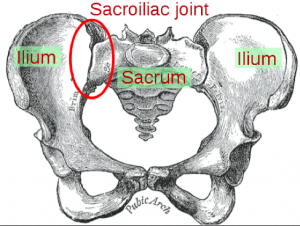
The SI joint is responsible for 12 to 25% of low back pain.
Recent studies have shown that 25% of the time, a person experiencing acute or chronic low back pain does not have a problem in the low back. The pain may actually be coming
from the sacroiliac joints or a person’s hip joint.
The sacroiliac joint is located in the very low back where the sacrum meets the pelvis on both the left and the right side. Arthritis may be present in one of these joints, and it may exacerbate from time to time. Additionally, an individual may have pathology in the hip joint such as arthritis or a cartilage tear that is causing pain (labral tear) that leads to low back pain.
A comprehensive physical examination and appropriate imaging work up may be able to elucidate where the pain is coming from. The person may need diagnostic injections into these areas to figure out exactly where the pain is coming from.
Spinal Tumor
Less commonly, an individual may be having acute or chronic low back pain coming from a tumor. This may be a primary bone tumor such as multiple myelitis or an osteoblastoma. Not all tumors are malignant. If an individual is having significant pain at rest along with night sweats or difficulty sleeping, then a work up for tumor should be initiated with appropriate blood work and imaging studies.
If you are experiencing either acute or chronic low back pain, the odds are very good that you can achieve substantial relief with Arizona Pain Specialists. With so many potential reasons for a person having low back pain, the Award-Winning, Board-Certified pain doctors and chiropractors at these AZ pain clinics are experts at the workup and
treatment.
Is important to have extensive options that can be customized to each particular patient’s situation. And that is exactly what Arizona Pain offers.
Arizona Pain serves patients with Phoenix pain management, Mesa, Tempe, Chandler, Glendale, Gilbert, Scottsdale, Fountain Hills, Surprise, Goodyear and more. Patients also routinely travel from Queen Creek, Casa Grande, and Maricopa to seek treatment with these pain management doctors in Arizona.
Call (602) 507 – 6550 to schedule your Appointment TODAY!

![]()






 flare up with painful exacerbations from time to time.
flare up with painful exacerbations from time to time.
